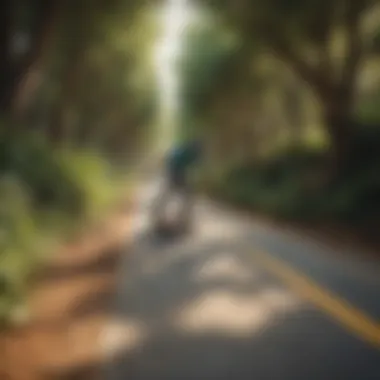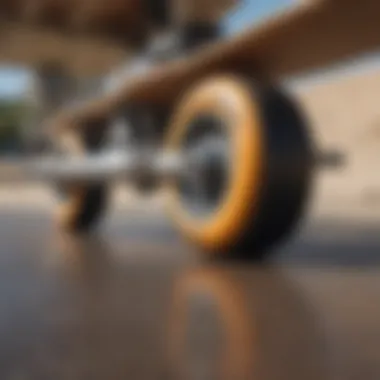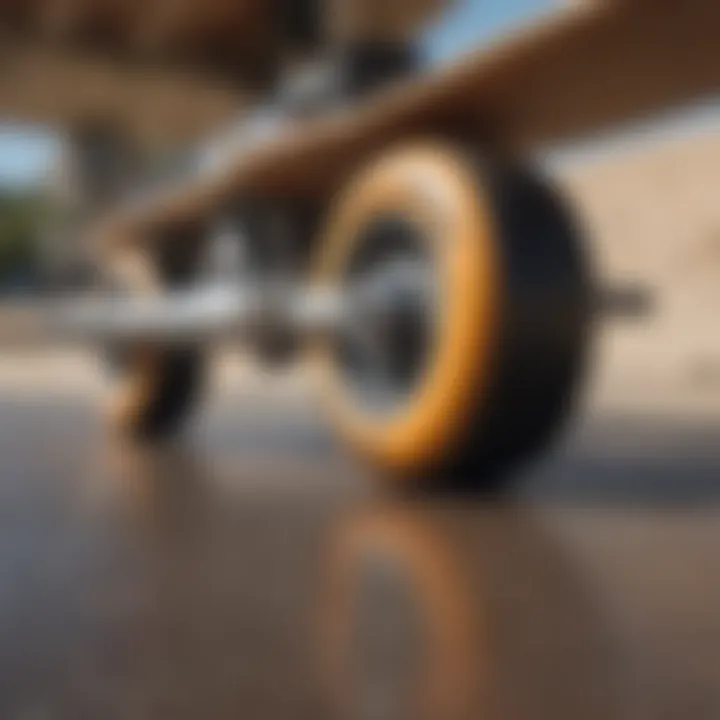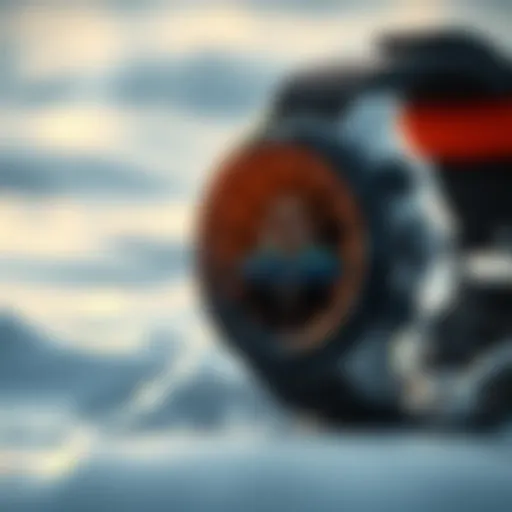Longboarding 101: The Art and Science of Riding


Intro
Longboarding, often perceived as a simple pastime, intertwines art and science in every ride. It’s not merely about the board beneath your feet; it’s about understanding the nuances of balance, momentum, and terrain. The act of gliding downhill or savoring the wind against your face evokes a feeling that is hard to replicate in today's fast-paced life. As riders, we are explorers, taking on the winding roads and city streets, navigating through either tranquil or bustling surroundings.
In this comprehensive guide, we pull back the curtain on the longboarding world, digging into its rich history and diverse styles, as well as the precise techniques that can elevate your ride from ordinary to extraordinary. Whether you're just stepping onto a board, or you've been carving through concrete for years, there's something here to enhance your understanding.
We will delve into the vital aspects surrounding longboarding culture. Essential safety practices are crucial to ensure not just enjoyment, but also protection as we navigate through various environments. Additionally, we’ll discuss equipment maintenance—a often overlooked aspect—enabling your gear to perform at its peak.
This exploration is not just about riding; it’s a journey into skill progression, offering you insights on how to elevate your craft step by step. With every glide, each turn, and the rhythm of our wheels against pavement, we uncover deeper layers of this activity. Let’s set the stage for an adventure—one where the road merges with the ride, crafting a narrative unique to each rider.
"Longboarding is not just movement; it’s a unique blend of physics, environment, and personal expression."
Now, we’ll begin to break down what makes longboarding unique. Understanding the components of your board, the styles available, and the techniques required will help refine your experience and enhance your journey on wheels.
Foreword to Longboarding
Longboarding is more than just a hobby; it's an art form that intertwines balance, skill, and passion. For those stepping onto a longboard for the first time, the experience can evoke a sense of freedom and exhilaration that few other activities provide. Understanding the fundamentals of longboarding is vital because it lays the groundwork for mastering techniques and appreciating the culture surrounding this exhilarating pastime.
The significance of this section cannot be overstated. Many enthusiasts view longboarding through the lens of sport or leisure; however, it transcends these categories. It also serves as a conduit for connecting with nature, socializing, and even creative expression through tricks and styles. Riders develop a unique relationship with their boards, which can be likened to an artist with their paintbrush.
Considering aspects such as body mechanics and physics is crucial. At its core, longboarding incorporates principles of balance, momentum, and gravity. Recognizing how these elements interact can enhance a rider's technique, leading to smoother rides and safer experiences. A thorough understanding of longboarding also means being aware of the local environment – the roads, hills, and parks that provide the surfaces we ride.
Notably, longboarding promotes a sense of community among devotees. Riders come together in all sorts of places, from bustling city streets to quiet trails. Local events and gatherings foster camaraderie and skill sharing, enriching the experience even further. For those yet to take the plunge into longboarding, this exploration of what makes it special could be the spark that ignites their journey.
What is Longboarding?
Longboarding is simply a variation of skateboarding that uses longer boards, typically ranging from 33 to 59 inches. The design caters to diverse riding styles and preferences. Unlike traditional skateboards, longboards are engineered for stability and a smoother ride over various terrains. Their longer wheelbase and softer wheels make downhill speeds more manageable and cruising easier, attracting both novices and seasoned riders alike.
Riders often use longboards for recreational fun, commuting, or racing downhill. Beyond mode of transport, longboarding is a lifestyle choice, steeped in unique traditions and culture that continue to evolve. Those who ride often speak about the feeling of gliding down a hill, hair blowing in the wind, embodying a sense of liberation that’s hard to convey through mere words.
A Brief History
The origins of longboarding can be traced back to the late 1950s and early 1960s, primarily in California. What began as surfing on concrete became a full-fledged movement as pioneers modified skateboards into longer and more stable boards. Shapers like George Powell and Stacy Peralta played significant roles in developing modern longboards, crafting them to match the demands of the growing skate culture.
As longboarding gained traction, various disciplines emerged, such as downhill, freeride, and dancing, each with its own set of techniques and tricks. By the late '90s and early 2000s, the longboarding community expanded further, giving birth to numerous competitions and events worldwide. With the rise of the internet, forums and social media platforms facilitated greater exchanges among riders, promoting knowledge-sharing and community-building.
Today, longboarding remains a multifaceted sport that combines the thrill of speed with the tranquility of leisurely rides through neighborhoods and parks alike. Its steady growth suggests an exciting future ahead, as more people discover the joys of longboarding and contribute to its rich tapestry.
Types of Longboards
Understanding the various types of longboards is foundational for anyone looking to embark on this thrilling journey. With each type of longboard crafted for different riding styles and environments, it's essential first to identify what kind of experience you desire. Whether you're carving up a city's streets, barreling down hills, or just enjoying a leisurely ride along the beach, there's a longboard suited to your needs.
Freeride Boards
Freeride boards are designed for riders who enjoy maneuverability and tricks. They're generally asymmetrical, providing a unique shape that allows for a wide range of movements without compromising stability. The decks on these boards are typically flexible, aiding in absorbing shocks and giving the rider a better feel for the terrain. It’s common for freeride riders to perform slides or sharp turns, making the ability to shift balance crucial.
Key features include:
- Wider decks: For better foot placement.
- Soft wheels: To provide grip and control while sliding.
When it comes to technique, practicing on a freeride board helps build confidence, especially when moving at higher speeds. Remember, these boards excel on both flat surfaces and gentle rolling hills, making them a versatile choice for the adventurous rider.
Downhill Boards
If speed is your game, downhill boards are your best bet. Built for stability and control at higher speeds, these boards are generally longer and lower to the ground. The aerodynamic design minimizes wind resistance, allowing for faster descents. On a quality downhill board, you'll typically find a stiff deck, which provides the necessary support for hard turns and downhill racing.
Their characteristics usually include:
- Narrow trucks: To enhance turning capabilities.
- Large wheels: For gliding smoothly over road imperfections.
When engaging in downhill riding, awareness of road conditions becomes vital. Riders need to practice proper stance and braking techniques to manage speeds safely. The thrill of zooming downhill gives a rush, but responsible riding remains paramount.
Cruiser Boards
Cruiser boards provide a laid-back riding experience, perfect for short jaunts around town or a casual day at the beach. These boards are typically shorter and offer an easier ride, making them ideal for beginners or those who want less intense sessions. Easy to maneuver, cruisers are enjoyable whether you're on a smooth boardwalk or navigating city streets.
Common elements found in cruiser boards:
- Flexible decks: For comfort and easy maneuverability.
- Medium-sized wheels: Providing a balance between speed and ease of control.
Cruisers are all about style and comfort. They can be personalized with different graphics and designs, making it easy to express personality while enjoying the ride. Plus, they're generally lightweight, meaning they're easy to carry around when not in use.
Electric Longboards
In a world where technology and outdoor fun intersect, electric longboards present an exciting option. These boards are equipped with electric motors to aid in propulsion, making it easier for riders to traverse longer distances without the same physical effort required by traditional longboards. Electric longboards come with various features, such as regenerative braking and adjustable speed settings.
Essential components include:


- Powerful batteries: Providing longer ride times.
- Remote controls: Allowing riders to adjust speed without foot effort.
Electric longboards open up new possibilities for urban commuting and extended rides through nature trails. They can seamlessly blend the thrill of riding with a convenient mode of transportation for daily activities.
"Choosing the right longboard type is like picking the right wave to surf; understanding its nuances can make all the difference in your experience."
Essential Components of a Longboard
Understanding the essential components of a longboard is crucial for any rider, be it a novice or a seasoned pro. Each element contributes significantly to the board's overall performance, safety, and your riding experience. This section will delve into the four primary components: decks, trucks, wheels, and bearings. Each part has its unique role and knowing these can enhance your choice when seeking a longboard tailored to your style.
Decks
The deck is the most visible part of the longboard. It's the foundation you stand on, so comfort and functionality are key. Decks come in various shapes, sizes, and materials. A well-constructed deck ensures stability and control.
- Material Considerations: Common materials include maple, bamboo, and fiberglass. Maple provides stiffness, ensuring that it can handle tough rides. Bamboo, on the other hand, offers flexibility, making it lighter and absorbent of vibrations from the road.
- Shape and Size: The shape determines your riding style. A drop-through deck lowers your center of gravity, making it easier to push off and cruise smoothly. In contrast, a pintail deck is great for carving and turns.
Choosing the right deck plays a pivotal role in defining your ride; it can make a longboard more suited for downhill racing or cruising along the boardwalk.
Trucks
Trucks are the metal parts that connect the wheels to the board’s deck. Their function is crucial because they affect how the board turns.
- Height and Width: Truck height can impact performance. Lower trucks provide a more stable ride, which is beneficial during downhill longboarding. Higher trucks allow for more aggressive turns, adding versatility at the cost of stability. The width of the trucks should match the width of the deck for optimal performance.
- Material Quality: Look for trucks made from durable materials, such as aluminum or magnesium. A strong truck minimizes the risk of breakage during intense rides.
Many riders often overlook trucks, but these components directly influence the handling and stability of the board.
Wheels
Wheels are another vital aspect, as they determine how your longboard interacts with the terrain. The hardness and durometer rating of wheels play a significant role in performance.
- Durometer: Softer wheels, typically rated between 78A-87A, provide more grip and are preferable for rough surfaces, while harder wheels are better for smooth surfaces and tricks. Most riders looking to cruise opt for softer wheels for their shock-absorbent qualities.
- Diameter: Wheel size also matters. Larger wheels roll over bumps more easily, which is great for downhill or off-road riding. Smaller wheels offer more control and are better for technical tricks.
Selecting wheels suited to your riding style can dramatically alter your experience and effectiveness on the board.
Bearings
Bearings are the small, round components that allow the wheels to spin freely. High-quality bearings contribute to a smoother ride.
- Material and Durability: Look for bearings made of stainless steel or ceramic for longevity and resistance to rust and friction. A well-lubricated bearing will not only last longer but will also enhance your speed.
- Rating: Bearings are often rated by the ABEC scale, which indicates their precision. A higher ABEC rating suggests better performance, but it’s essential to consider how this impacts your riding style. Sometimes, a lower rating can serve just as well when it comes to cruising.
Remember: It's not just about how good your board looks; it's about how well it rides and fits your individual needs.
Techniques and Riding Styles
When it comes to longboarding, the finesse with which one maneuvers the board can greatly affect not just the joy of riding but also the rider's overall skill development. Mastering various techniques is essential for unlocking the full potential of any longboard. A skateboard might get you from A to B but longboarding allows for a broader palette of movements and styles that can transform the experience into an art form of its own.
Carving
Carving is like painting an abstract on the pavement, where the rider guides the board in smooth, elegant arcs that resemble the swells of ocean waves. This technique is characterized by the rider making wide, sweeping turns, which not only enhances the flow of riding but also helps maintain speed and control.
To master carving, keep the following points in mind:
- Body Position: Your weight should be shifted subtly back and forth, engaging your knees and hips to direct the board.
- Lean into Turns: A slight lean toward the direction you wish to carve is key. It’s almost like your body and the board become extensions of each other.
- Practice: Start on flat, smooth surfaces before tackling hilly terrains. It’s all about finding that sweet spot of balance and momentum.
Carving is not just about aesthetics; it actively improves your board control and helps you anticipate changes in road conditions.
Sliding
Sliding offers a level of exhilaration that can hardly be described until experienced firsthand. Unlike carving, sliding involves deliberately losing traction with the wheels, allowing the rider to come to a controlled stop or to change direction without the need for slowing down first.
Here are crucial considerations to slide effectively:
- Foot Placement: Keep your back foot over the tail of the board. The front foot will help guide the slide, while the rear foot enables you to initiate and maintain the slide.
- Speed Control: Timing and speed are crucial. Too fast and you may spiral out of control; too slow and the slide might not happen at all.
- Safety First: Wear protective gear because falling is part of learning. Maintain a cool head while practicing in less trafficked areas.
The rush of a well-executed slide can be addictive, pushing you to refine your abilities further.
Dancing
Dancing on a longboard blends technical skills with creativity, where balance and fluidity come into play. It’s a style that incorporates footwork, spins, and tricks that resemble choreographed movements rather than mere riding. This technique makes the rider look like they're elegantly gliding through a dance rather than just commuting.
Key aspects to focus on include:
- Footwork: The ability to switch between different stances while maintaining balance is essential. Practice shifting your weight from foot to foot smoothly.
- Upper Body Movement: Your arms and shoulders can guide the direction of your shifts. Use them to create rhythm and flow.
- Board Choice: A longer, wider deck provides more space for performing tricks and is generally more stable, making it easier to practice dancing techniques.
The blend of art and athleticism in dancing can transform a simple ride into a captivating visual experience.
"Longboarding isn't just a method of transportation; it's a form of expression, a way to convert the surface of the earth into your own personal canvas of movement."


In summary, understanding and practicing these techniques not only elevates your skills but also enhances the overall longboarding experience. It makes each ride unique, helping you to discover new facets of freedom on four wheels.
Safety Considerations
Riding a longboard can be both thrilling and liberating, much like riding the waves on a surfboard. However, enjoyment comes with a responsibility to stay safe. Understanding safety considerations in longboarding isn't just about wearing gear; it's a whole mindset. From minimizing risks to enhancing the overall riding experience, safety plays a critical role in longboarding culture. The true essence of freedom on wheels stems from the confidence that comes with knowing you’re prepared for whatever the ride throws at you.
Protective Gear
When it comes to protective gear, there’s no such thing as overkill. A good helmet is your best friend. Whether you’re cruising down a gentle slope or tackling steeper hills, a proper helmet protects your noggin. Look for ones that meet safety standards, like those from the CPSC (Consumer Product Safety Commission).
But that's just the start. Elbow pads and knee pads are essential too. Sliding off your board at high speed can lead to severe scrapes and bruises. Having good pads may be the difference between a simple wipeout and a trip to the hospital.
Here are a few pieces of gear you should consider:
- Helmet: Opt for a full-face model if you’re into downhill riding for maximum protection.
- Wrist Guards: Prevents wrist fractures during fall—common injuries for beginners.
- Elbow and Knee Pads: Great for both newbies and seasoned riders to avoid serious injuries.
- Slide Gloves: If you’re into sliding, these can help save your palms while providing grip.
Wearing protective gear not only boosts your safety but also gives you the confidence to push your limits. Not every ride has to be risky to be exciting.
Understanding Road Conditions
The amount of caution you exercise on different road conditions can greatly impact your experience. Just as surfers respect the ocean's temperament, longboarders need to respect the asphalt below their wheels. Riding can vary from smooth city streets to rugged mountain paths. Conditions change due to factors such as weather, road quality, and traffic.
- Pavement Quality: A smooth, well-maintained surface allows for smoother rides. Crack riddled roads or patches filled with debris require heightened attention.
- Weather Conditions: Wet surfaces can be a recipe for disaster. Rain causes loss of traction, so it’s wise to stay off your board during slippery conditions.
- Traffic Awareness: Always be aware of your surroundings. Just like surfers heed waves and swimmers, longboarders must navigate vehicles and pedestrians. This means checking off intersections, staying clear of parked cars, and paying attention to cyclists.
"Respect the road, know its limits, and your longboard will thank you—a smooth ride rewards the cautious rider."
Being educated about road conditions not only safeguards you but also ensures a more enjoyable ride. When conditions are right, it's like dancing on wheels—smooth and flowing without interruptions.
Choosing the Right Longboard
Finding the right longboard is like finding a good pair of shoes; it can make all the difference in comfort and performance. A longboard isn’t just a piece of wood with wheels, it’s an extension of your riding style, a tool that enhances your experience on the pavement. With various types and configurations available, choosing the appropriate longboard is crucial for both beginners and seasoned riders alike.
When selecting a longboard, consider your riding plans. Are you looking to cruise down the sidewalk, hitting ramps and performing tricks? Or are you more interested in carving through hills at high speeds? The answer to these questions will guide you in choosing the right board for your needs.
Sizing Your Longboard
Size matters—as cliché as it sounds, it holds true in longboarding. The right size can significantly impact your stability, control, and overall riding experience. Longboards come in various lengths, typically ranging from 28 inches to 60 inches.
- Short boards (28"-36"): These provide greater maneuverability, making them ideal for tricks and urban riding. If you're weaving through city streets, a shorter board can help with tight turns.
- Mid-sized boards (36"-46"): A balance between stability and agility, these boards are suitable for cruising and easier to control at moderate speeds.
- Long boards (46" and above): Offering greater stability, especially at high speeds, these boards are perfect for downhill riding. If you're planning on hitting steep hills, go for a longer board to ensure a more secure ride.
It's also important to consider your height and weight when sizing up. A lighter rider on a longer board might feel less control, while a heavier rider might need that extra size for stability. Get a feel for different sizes before settling down on one that fits your style.
Material Considerations
Just as crucial as size is the material of your longboard. The structure of the board affects its flex, durability, and weight. Different materials serve different riding styles. Here’s a quick rundown:
- Maple wood: This is a popular choice due to its resilience and strength. Maple often provides a stiff ride, suitable for downhill longboarding.
- Bamboo: Known for its flexibility, bamboo boards offer a smooth ride, absorbing vibrations and providing comfort during cruising.
- Composite materials: Made from a mixture of materials, these boards can offer a balance of weight and sturdiness, making them versatile for various riding styles.
When choosing the board, also keep an eye on the construction techniques, like whether it's a drop-through or drop-down board. Drop-through boards lower the center of gravity, making them easier to push or glide on flat surfaces, while drop-down boards can enhance stability at high speeds.
"Choosing the right longboard comes down to aligning your needs with specific characteristics of the board. It's essential to consider your riding environment and personal preferences in material and size.”
In the end, finding the right longboard feels like piecing together a puzzle—get the right size, material, and type, and you’re set to enjoy the ride like never before.
Maintaining Your Longboard
When it comes to longboarding, the joy of gliding down a smooth road or carving through a park can quickly turn into a drifting disappointment if the board isn't properly maintained. Taking time to care for your longboard doesn’t just enhance its performance; it also extends its lifespan. Longboards endure a lot from friction, dirt, and the elements, which can cause wear and tear. This section dives into vital aspects of maintenance that every rider should be familiar with.
Regular Inspections
Regular inspections of your longboard can make a world of difference. Every now and then, give your board a thorough once-over to catch any emerging issues before they escalate. The key components to check include:
- Deck: Look for scratches, cracks, or delamination. A sturdy deck keeps you stable.
- Trucks: Ensure they are not loose or rusty. Worn-out trucks can affect control and handling.
- Wheels: Check for flat spots and wear. Uneven wheels may cause vibrations which can spoil a smooth ride.
- Bearings: Give them a spin. If they aren't turning freely, it might be time for a clean.
While some of this is straightforward, it’s essential to remember that catching a small issue can prevent a larger one. Think of it like maintaining a car; frequent checks save you from breakdowns.
Cleaning Techniques
Keeping your longboard clean may seem like a chore, but it pays off in the long run. Dirt can accumulate and affect the components of the board. Here are some effective cleaning techniques:
- Wheels and Bearings: Remove the wheels and bearings for a proper cleaning. A simple rinse with warm, soapy water can work wonders. For bearings, using a dedicated bearing cleaner or rubbing alcohol helps to dislodge any grime that hinders performance.
- Deck Cleaning: Use a damp cloth to wipe down the deck. For grip tape, a light brush can help to clear debris without removing the grit.
- Trucks: Keep the trucks tidy by using a wet cloth to wipe off any dirt or rust. You can use a bit of lubricant on the pivot points, but not too much to avoid attracting more dust.
"An ounce of prevention is worth a pound of cure." This saying rings true when it comes to maintaining your gear. A little effort in upkeep goes a long way in ensuring you keep your wheels rolling smoothly.
By weaving these regular inspections and cleaning techniques into your longboarding routine, your board will not only look sharp but also perform at its best. The smoother the ride, the more joyful the journey, underscoring the relationship between a well-maintained longboard and a happy rider.
The Longboarding Community


Longboarding is not just a means of transportation or a sport; it's a vibrant community that brings together people from all walks of life. The camaraderie among riders can often be felt at spots where enthusiasts gather to practice their skills, exchange tips, or simply enjoy a day out. As a longboarder, becoming part of this community can significantly enhance your experience, providing motivation and resources for perfecting your craft.
Events and Competitions
Events and competitions serve as focal points for the longboarding community. The excitement is palpable during gatherings that range from local meetups in the park to international competitions winding through scenic mountains or urban landscapes. These events offer riders a platform to demonstrate their skills, learn from each other, and connect with fellow enthusiasts.
Notably, races like the Downhill Gold Rush in California attract some of the best riders from around the globe. Competitions encourage friendly rivalry and inspire participants to push their limits. The thrill of flying down a winding road, surrounded by other passionate riders, creates memories that stick for a lifetime.
Moreover, participating in these events fosters a sense of belonging. Whether you're competing for the top spot or just participating for the fun of it, being around like-minded individuals can uplift your spirits. You'll often find food trucks, live music, and vendors selling gear, which transforms contests into festive occasions—not purely about the competition but also about community spirit.
Online Forums and Social Media
In the digital age, online forums and social media platforms play a crucial role in uniting longboarders. Sites like reddit.com and dedicated Facebook groups provide platforms for enthusiasts to share their experiences, troubleshoot issues, and celebrate their passions. These interactions ultimately help develop skills that might otherwise take years to acquire.
On these platforms, a rider can post a video of their latest trick and receive constructive feedback from experienced peers. Discussion threads can range from tips on maintaining your longboard to sharing recommendations for the best trails in your area. The quality of online interactions can sometimes rival in-person connections, providing a continuous learning environment.
In addition to individual connections, communities on social media often come together for large-scale initiatives, like planning group rides or clean-up events to maintain riding locations. This community-building aspect demonstrates a collective commitment not just to the sport, but to the environment as well.
In sum, the longboarding community is a diverse tapestry woven through events, online interactions, and shared experiences that amplify the joy of riding while nurturing a supportive network for all levels of riders.
Environmental Impact and Conservation
Understanding the environmental impact of longboarding is essential, as our choice of recreational activities influences the planet. With the increasing popularity of this sport, riders must consider how their passion affects the environment. Longboarding isn’t just about riding; it’s about engaging with the world around us.
Longboarding can leave a footprint, both in terms of physical damage to riding locations and the larger ecological implications of our practices. The balance of enjoying this activity while respecting nature is a tightrope walk that requires awareness and action.
Sustainable Practices
Riders play a pivotal role in advocating for sustainable practices. Here’s how they can contribute:
- Eco-friendly Boards: Many manufacturers are now creating longboards from sustainable materials like bamboo or recycled plastics. Opting for such options reduces reliance on non-renewable resources.
- Responsible Waste Management: Using and disposing of your longboarding gear properly is key. Riding doesn't come without equipment wear and tear. Instead of tossing out old gear, consider repairing or recycling it instead.
- Carbon Footprint Awareness: Longboarding can serve as an alternative mode of transportation. Choosing to skateboard for short trips instead of driving helps cut down carbon emissions, benefiting the planet.
- Local Gear Shops: Support local shops that prioritize sustainability in their products. This not only strengthens the local economy but also reduces transportation emissions.
Engaging in these practices will allow riders to enjoy their hobby while mitigating negative impacts on the environment.
Protecting Riding Locations
Riding locations are sacred spaces that should be cherished and preserved. To ensure these spaces remain accessible for future riders, consider the following:
- Leave No Trace: Always clean up after your rides. This means not just packing out your trash but also being mindful of the surrounding environment. Ensure nothing left behind inadvertently harms wildlife or damages the habitat.
- Respect Local Regulations: Some areas may have specific rules regarding where you can ride. By adhering to these regulations, riders help preserve natural spaces and promote a positive image for the longboarding community.
- Community Involvement: Consider joining local conservation efforts or clean-up days in areas where you ride. Being part of a community effort reinforces the importance of these locations and fosters relationships between riders and local residents.
- Spread Awareness: Share your passion for protecting riding locations on social media or engage in discussions within longboarding forums. The more awareness you create, the more your peers might take eco-conscious measures.
Protecting our riding spaces is akin to maintaining a sacred bond with nature; it ensures generations can experience the thrill of longboarding while respecting the land.
By keeping these considerations in mind, longboarders can foster an environment that nurtures their love for the sport while ensuring the protection of our planet.
Progressing in Longboarding Skills
Longboarding is more than just a sport; it's a dynamic mix of art and science. Within this realm, the ability to progress in skills is a vital component. Enhancing your longboarding skills isn’t only about mastering tricks; it encourages self-confidence, fosters community engagement, and broadens the horizons of what’s possible on a board. As you progress, you’ll encounter new challenges and experiences that enrich your journey.
Setting realistic and attainable goals can serve as a map, helping to navigate the sometimes winding road of skill development. There’s a saying among seasoned riders: "A smooth sea never made a skilled sailor." This reminds us that challenges are often the best teachers, and taking on difficult maneuvers can lead to unexpected breakthroughs in your riding abilities. As you progress, make sure to continuously assess and adapt your goals based on your performance and experiences.
Setting Goals
In the world of longboarding, goal-setting is crucial. It provides structure and direction, ensuring that you don't just drift like a leaf in the wind. Here are some key points to consider when setting your goals:
- Specificity: Your goals should be clear and specific. Instead of saying, "I want to get better," try something like, "I want to learn how to carve tighter turns by the end of the month."
- Measurable: Establish measurable milestones. Counting the number of successful runs you complete in a session can provide tangible evidence of progress.
- Attainable: Ensure that your goals are realistic. Challenge yourself but remain aware of your current skill level to avoid frustration.
- Time-bound: Set a timeline. Having a deadline creates a sense of urgency; for example, plan to master a new trick within four weeks.
Practicing Techniques
The art of practicing techniques is where progress meets dedication. This isn’t about mindlessly repeating moves; it’s about deliberate practice. Here are some strategies to enhance your technique:
- Focus on Fundamentals: Before diving into advanced tricks, ensure your basics are rock solid. This includes stance, balance, and understanding the mechanics of your board.
- Video Review: Recording yourself while riding can provide insights into areas needing improvement. Watching a playback can make you realize mistakes that aren’t obvious in the moment.
- Diverse Terrain: Practicing in various environments helps adapt your skills. From smooth pavement to rough roads, different surfaces can teach you to adjust your riding style.
"Miles of pavement will not teach you what a minute on the hill will."
- Skill-focused Sessions: Instead of simply riding, dedicate sessions to specific skills. Spend one day focusing on carving, and another on sliding.
- Peer Learning: Riding with others can drastically improve skill progression. Watching peers can inspire you and provide a communal understanding of techniques. Often, an experienced friend can offer guidance and tips you might overlook.
In summary, progressing in longboarding skills isn't merely about achieving the next trick or speed. It's about fostering a deeper connection to the sport, gaining confidence, and creating memorable experiences along the way. With clear goals and focused practice, the possibilities are endless, and the ride becomes all the more exciting.
Culmination
The conclusion of this guide to longboarding serves as a pivotal point for both newcomers and seasoned riders. It offers a moment of reflection on all the elements discussed throughout the article. Understanding longboarding is not just about mastering technical skills or choosing the right equipment. It's about fostering a deeper appreciation for the community, the environment, and the culture surrounding this exhilarating activity.
The Future of Longboarding
Looking ahead, the future of longboarding seems promising, brimming with possibilities. The rise of electric longboards signals a shift in how riders navigate their surroundings, blending technology with a traditional pastime. As technology advances, we can expect not only improvements in board design and safety features but also an increase in accessibility for new enthusiasts.
Social media platforms and online communities, like those on Reddit or Facebook, play significant roles in connecting riders from diverse backgrounds. These platforms transport ideas and experiences, encouraging skill-sharing and thriving local scenes. This interconnectedness inspires innovations and evolving riding styles, propelling the sport into exciting territory. However, as the community grows, it becomes critical to address sustainable practices to ensure the natural spaces we cherish remain intact. Protecting these riding locations secures the longevity of longboarding for future generations.
Final Thoughts
Ultimately, longboarding transcends its basic definition as just a sport. It embodies a lifestyle that fosters creativity, independence, and camaraderie. Whether carving smooth lines down a hillside or cruising along the beachside, riders cultivate a unique bond with the environment and one another.
Reflecting on this journey, remember that the joy in longboarding often lies in the small things – the thrill of a new technique, the beauty of a scenic path, the friendships formed along the way. For those passionate about longboarding, embracing these nuances enriches the experience further. To ride is to learn, and each ride invites new insights and adventures. The vibrant culture surrounding longboarding urges everyone to strap on their helmets, push off, and explore.
Let your wheels roll as far as your dreams take you.















